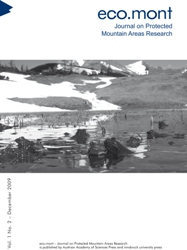Juliane Geyer,
Fedir D. Hamor,
Pierre L. Ibisch
S. 5 - 12
doi:
10.1553/ecomont2s5
Verlag der Österreichischen Akademie der Wissenschaften
doi:
10.1553/ecomont2s5
Abstract:
The Carpathian Biosphere Reserve (CBR) in Ukrainian Transcarpathia, formally recognized by UNESCO in 1992, is one of the most important protected areas in Europe. In 2007, the beech forests of Uholka were included into the UNESCO World Heritage Site Primeval Beech Forests of the Carpathians because of their uniqueness. In the course of the reserves spatial development and the potential integration of populated areas, participatory management arises as a crucial challenge. A first study of local stakeholders (private and state forestry enterprises, local communities), their attitudes and potential conflicts as well as synergies was conducted in 2008. Local communities, especially authorities, generally have a fairly positive attitude towards sustainable development and cooperation. Conflicts exist mainly between the CBR and the forestry sector, which is presently least oriented towards sustainability and rather focussed on economic revenue. We identified a common, but not insurmountable, lack of communication and cooperation between stakeholders. Local acceptance of the CBR is growing. Therefore the CBR can take the lead in applying a more integrative and participatory conservation management approach.
2009/11/26 12:28:44
Object Identifier:
0xc1aa5576 0x0022aa07
Rights:https://creativecommons.org/licenses/by-nc-nd/4.0/
The journal “eco.mont” – Journal of protected mountain areas research and management – was published for the first time in June 2009.
The journal was founded as a joint initiative of the Alpine Network of Protected Areas (ALPARC), the International Scientific Committee on Research in the Alps (ISCAR), the Austrian Academy of Sciences (ÖAW) and the University of Innsbruck.
The journal aims to highlight research on and management issues in protected areas in the Alps without excluding other protected mountain areas in Europe or overseas. Its target audiences are scientists from all related disciplines, managers of protected areas and interested individuals including practitioners, visitors, teachers, etc.
The journal presents peer-reviewed articles in English by authors who research protected mountain areas and management issues within these areas. It's published twice a year as a collaboration of the Austrian Academy of Sciences Press – responsible for the e-version – and Innsbruck University Press – responsible for the print version.
Die Zeitschrift „eco.mont“ – Zeitschrift zur Forschung in Gebirgsschutzgebieten – erschien im Juni 2009 zum ersten Mal. Die Zeitschrift wurde auf Initiative des Netzwerks Alpiner Schutzgebiete (ALPARC), der Schweizer Akademie der Naturwissenschaften (ISCAR), der Österreichischen Akademie für Wissenschaft (ÖAW) und der Universität Innsbruck gegründet. Sie hat das Ziel, Themen zu behandeln, die gleichzeitig Forschung und Verwaltung in und über die Schutzgebiete der Alpen betreffen, ohne dabei andere Gebirgsschutzgebiete Europas oder anderswo auszuschließen. Diese neue Zeitschrift richtet sich an ein Publikum von Wissenschaftlern der verschiedensten Fachbereiche, an die Verwalter von Schutzgebieten und an alle sonstigen Interessierten, Praktiker, Besucher, Lehrpersonal etc. einbegriffen. Die Zeitschrift veröffentlicht begutachtete Beiträge auf Englisch von Autoren, die Fragen der Gebirgsschutzgebieten und deren Verwaltung forschen. Sie erscheint zweimal pro Jahr, auf der Basis der gemeinsamen Anstrengungen des Verlags der Österreichischen Akademie der Wissenschaften, der für die digitale Fassung verantwortlich ist, und der Presse der Universität Innsbruck, verantwortlich für die gedruckte Fassung.



 Home
Home
 Print
Print
 References
References
 Share
Share

